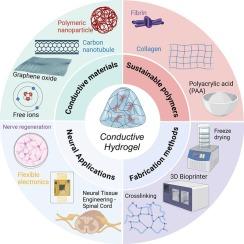Sustainable hydrogels as conductive platforms for neural applications
IF 5.1
3区 工程技术
Q1 CHEMISTRY, APPLIED
引用次数: 0
Abstract
Conductive hydrogels, an emerging class of biopolymers and biomaterials, have gained significant attention because of their combination of water retention properties and electrical conductivity. The hydrogel consists of a water-based matrix capable of transporting charges, resulting in improved processability and desirable biochemical and electrochemical characteristics. Owing to their versatile and sensitive nature, these gels are ideal candidates for medical devices with enhanced biocompatibility and functionality. By integrating conductive materials such as polypyrrole, graphene, and carbon nanotubes, these gels exhibit remarkable flexibility, high water content, and electrical conductivity, making them suitable for applications across various fields. One area where these conductive gels have significant potential is the regeneration and repair of damaged neural tissue, a challenge that conventional methods often do not address owing to the complexity of replicating the intricate anatomical and functional characteristics of the nervous system. They offer a promising alternative by mimicking the natural microenvironment of glial, neuronal, and stromal cells, enhancing stem cell-based therapies. The hydrogel matrix's integration with conductive elements makes electrical signal transmission possible. By mimicking the elastic properties of brain tissues, these gels facilitate the normal flow of signals and encourage neuronal regeneration by enhancing synaptic connections and promoting cell proliferation. This review examines the impact of integrating conductive materials with gels in managing neural damage for improved therapeutic outcomes. Additionally, the classification, properties, and fabrication of sustainable gels are discussed. This review also discusses the immense potential of the conductive gels in cutting-edge neurological applications, such as brain-machine interfaces and prosthetic devices, and they offer promising platforms for treating neural damage.

可持续水凝胶作为神经应用的导电平台
导电性水凝胶是一类新兴的生物聚合物和生物材料,因其兼具保水性和导电性而备受关注。水凝胶由能够传输电荷的水基基质组成,从而提高了可加工性和理想的生化和电化学特性。由于其多用途和敏感的性质,这些凝胶是具有增强生物相容性和功能的医疗器械的理想候选者。通过集成导电材料,如聚吡咯、石墨烯和碳纳米管,这些凝胶具有卓越的柔韧性、高含水量和导电性,使其适用于各种领域。这些导电凝胶具有巨大潜力的一个领域是受损神经组织的再生和修复,由于复制神经系统复杂的解剖和功能特征的复杂性,传统方法通常无法解决这一挑战。它们通过模拟神经胶质细胞、神经元细胞和基质细胞的自然微环境,增强了基于干细胞的治疗,提供了一种有希望的替代方案。水凝胶基质与导电元件的集成使电信号的传输成为可能。通过模拟脑组织的弹性特性,这些凝胶通过增强突触连接和促进细胞增殖来促进信号的正常流动和促进神经元再生。这篇综述探讨了将导电材料与凝胶结合在神经损伤管理中对改善治疗结果的影响。此外,还讨论了可持续凝胶的分类、性质和制备方法。本文还讨论了导电凝胶在尖端神经学应用中的巨大潜力,如脑机接口和假肢装置,它们为治疗神经损伤提供了有前途的平台。
本文章由计算机程序翻译,如有差异,请以英文原文为准。
求助全文
约1分钟内获得全文
求助全文
来源期刊

Reactive & Functional Polymers
工程技术-高分子科学
CiteScore
8.90
自引率
5.90%
发文量
259
审稿时长
27 days
期刊介绍:
Reactive & Functional Polymers provides a forum to disseminate original ideas, concepts and developments in the science and technology of polymers with functional groups, which impart specific chemical reactivity or physical, chemical, structural, biological, and pharmacological functionality. The scope covers organic polymers, acting for instance as reagents, catalysts, templates, ion-exchangers, selective sorbents, chelating or antimicrobial agents, drug carriers, sensors, membranes, and hydrogels. This also includes reactive cross-linkable prepolymers and high-performance thermosetting polymers, natural or degradable polymers, conducting polymers, and porous polymers.
Original research articles must contain thorough molecular and material characterization data on synthesis of the above polymers in combination with their applications. Applications include but are not limited to catalysis, water or effluent treatment, separations and recovery, electronics and information storage, energy conversion, encapsulation, or adhesion.
 求助内容:
求助内容: 应助结果提醒方式:
应助结果提醒方式:


